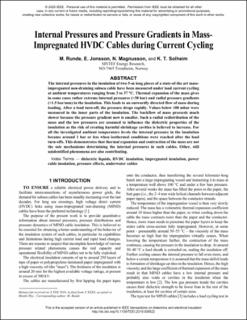| dc.contributor.author | Runde, Magne | |
| dc.contributor.author | Jonsson, Erik | |
| dc.contributor.author | Magnusson, Niklas | |
| dc.contributor.author | Solheim, Kristian Thinn | |
| dc.date.accessioned | 2020-11-26T12:48:58Z | |
| dc.date.available | 2020-11-26T12:48:58Z | |
| dc.date.created | 2020-05-28T09:16:43Z | |
| dc.date.issued | 2020 | |
| dc.identifier.citation | IEEE transactions on dielectrics and electrical insulation. 2020, 27 (3), 915-923. | en_US |
| dc.identifier.issn | 1070-9878 | |
| dc.identifier.uri | https://hdl.handle.net/11250/2689798 | |
| dc.description.abstract | The internal pressures in the insulation of two 5-m long pieces of a state-of-the art mass-impregnated non-draining subsea cable have been measured under load current cycling at ambient temperatures ranging from 3 to 37 °C. Thermal expansion of the mass gives in some cases rather extreme internal pressures (>30 bar) and radial pressure gradients (>1.5 bar/mm) in the insulation. This leads to an outwardly directed flow of mass during loading. After a load turn-off, the pressure drops rapidly. Values below 100 mbar were measured in the inner parts of the insulation. The backflow of mass proceeds much slower because the pressure gradient now is smaller. Such a radial redistribution of the mass and the low pressures are assumed to influence the dielectric properties of the insulation as the risk of creating harmful shrinkage cavities is believed to increase. For all the investigated ambient temperature levels the internal pressure in the insulation became around 1 bar or less when isothermal conditions were reached after the load turn-offs. This demonstrates that thermal expansion and contraction of the mass are not the sole mechanisms determining the internal pressures in such cables. Other, still unidentified phenomena are also contributing. | en_US |
| dc.language.iso | eng | en_US |
| dc.publisher | IEEE | en_US |
| dc.title | Internal pressures and pressure gradients in mass-impregnated HVDC cables during current cycling | en_US |
| dc.type | Peer reviewed | en_US |
| dc.type | Journal article | en_US |
| dc.description.version | acceptedVersion | en_US |
| dc.rights.holder | IEEE | en_US |
| dc.source.pagenumber | 915-923 | en_US |
| dc.source.volume | 27 | en_US |
| dc.source.journal | IEEE transactions on dielectrics and electrical insulation | en_US |
| dc.source.issue | 3 | en_US |
| dc.identifier.doi | 10.1109/TDEI.2019.008522 | |
| dc.identifier.cristin | 1812951 | |
| dc.relation.project | Norges forskningsråd: 256505 | en_US |
| cristin.ispublished | true | |
| cristin.fulltext | postprint | |
| cristin.qualitycode | 1 | |
